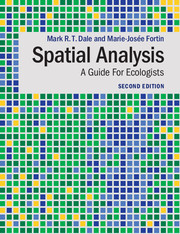Book contents
- Frontmatter
- Dedication
- Contents
- Preface
- 1 Spatial concepts and notions
- 2 Ecological and spatial processes
- 3 Points, lines and graphs
- 4 Spatial analysis of complete point location data
- 5 Contiguous units analysis
- 6 Spatial analysis of sample data
- 7 Spatial relationship and multiscale analysis
- 8 Spatial autocorrelation and inferential tests
- 9 Spatial partitioning: spatial clusters and boundary detection
- 10 Spatial diversity analysis
- 11 Spatio-temporal analysis
- 12 Closing comments and future directions
- References
- Index
2 - Ecological and spatial processes
Published online by Cambridge University Press: 05 September 2014
- Frontmatter
- Dedication
- Contents
- Preface
- 1 Spatial concepts and notions
- 2 Ecological and spatial processes
- 3 Points, lines and graphs
- 4 Spatial analysis of complete point location data
- 5 Contiguous units analysis
- 6 Spatial analysis of sample data
- 7 Spatial relationship and multiscale analysis
- 8 Spatial autocorrelation and inferential tests
- 9 Spatial partitioning: spatial clusters and boundary detection
- 10 Spatial diversity analysis
- 11 Spatio-temporal analysis
- 12 Closing comments and future directions
- References
- Index
Summary
Introduction
Explicit considerations of spatial structure have come to play an increasingly important role in understanding ecological processes. The reason for this trend lies in the fact that every important ecological process takes place in a spatial context and may involve a spatial structure that affects or determines the detail of the outcome. To simplify our approach to an ecological process such as predation or eutrophication by averaging over locations (and times) does provide an easier path for such studies, but can, in the end, mislead by ignoring the heterogeneity and detailed circumstances that are crucial to the understanding we seek. Most organisms do not live in uniform environments; they encounter environmental gradients of abiotic and biotic origin, disturbance and the changes that follow it, and two- or three-dimensional mosaics with polygons and boundaries between. All of these represent spatial structure that affects the processes, and those effects may differ by the level of organization: individuals, populations, ecosystems, and so on. In this chapter, we provide an introductory discussion of the relationships between the spatial and ecological processes we study and wish to understand.
Ecological processes and spatial structure
In this section, we review the processes that are most directly relevant to the fundamentals of spatial analysis in ecology, admittedly with a bias toward plant communities. Included are both biological and environmental processes, particularly different kinds of disturbance, but disturbance usually triggers a cascade of biological processes affecting spatial structure, such as mortality, dispersal, establishment, regeneration, growth, and competition. These biological processes interact with abiotic processes, both past (called spatial legacy) and present, to produce the current spatial pattern and spatial dynamics. While it is tempting to hope that we can deduce the past processes that gave rise to a currently observed spatial pattern, we must recognize that this is not always possible: the same process may result in different patterns, and different processes may give rise to indistinguishable patterns (cf. Figure 1.2). The patchiness of the environment or habitat can be the result of the growth pattern or architecture of organisms, such as clonal groves of aspen, or the result of topography, such as post-glacial knob-and-kettle landscapes with an alternation of ridges and ponds. In addition, even the same process may have several mechanisms contributing to it; therefore, we will focus on spatial aspects of process, not on the details of mechanisms.
Information
- Type
- Chapter
- Information
- Spatial AnalysisA Guide For Ecologists, pp. 32 - 45Publisher: Cambridge University PressPrint publication year: 2014
